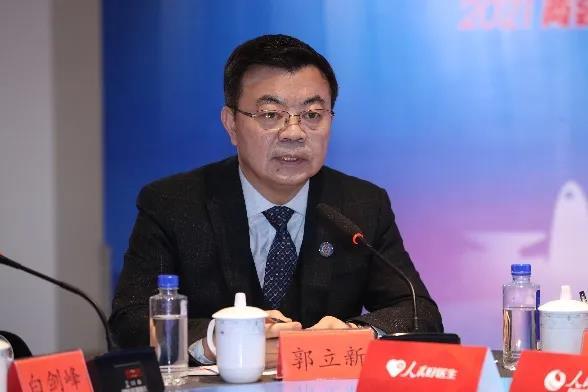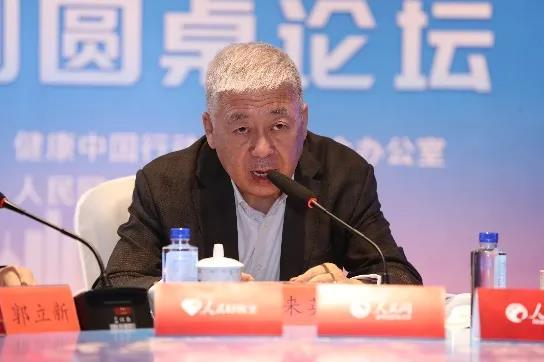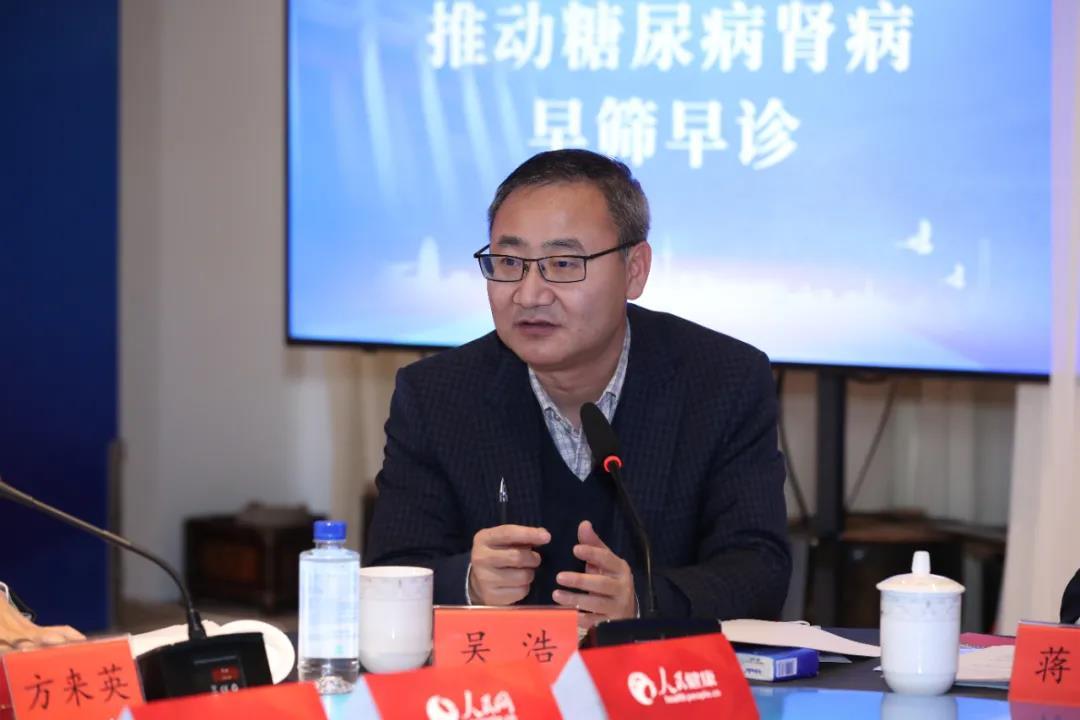Representatives of the two sessions called for: promoting early screening and early diagnosis of diabetic nephropathy, and improving the management level of major chronic diseases
Date:
2021-03-25
There are more than 130 million diabetic patients in China. Diabetes is one of the public problems that seriously affect the health of Chinese people. The harm caused by complications of diabetes is not only related to the lives and health of the people, but also affects the quality of my country's labor force. On the occasion of the National Two Sessions in 2021, a special roundtable forum on "Healthy Chinese: Promoting Early Screening and Diagnosis of Diabetic Kidney Disease" was held in Beijing. The forum was hosted by People's Daily Online under the guidance of the Office of the Healthy China Action Promotion Committee. Representatives, experts and scholars attending the two sessions actively discussed the measures and means to promote early screening and early diagnosis of diabetic nephropathy, and offered advice and suggestions to improve the management level of major chronic diseases such as diabetes in my country, aiming to realize the established diabetes as soon as possible in the "Healthy China Action (2019-2030)" preventive action goals.
Fang Laiying, member of the National Committee of the Chinese People's Political Consultative Conference, vice president of the Chinese Hospital Association, deputy to the National People's Congress, vice president of Guizhou Provincial People's Hospital, standing member of the Nephrology Branch of the Chinese Medical Association, Zha Yan, director of the Endocrinology Department of Beijing Hospital, and candidate for the Diabetes Branch of the Chinese Medical Association Chairman Guo Lixin, member of the National Committee of the Chinese People's Political Consultative Conference, Wu Hao, director of the Beijing Fangzhuang Community Health Service Center, Jiang Wei, assistant director of the China Center for Disease Control and Prevention, director of the General Office Jiang Wei, and other representatives of the two sessions, experts and scholars jointly appealed: policy guidance should be clarified as soon as possible , Establish a diabetic nephropathy prevention and control system, improve the awareness of diabetic nephropathy screening in the whole society, incorporate early screening and early diagnosis indicators into the assessment of medical staff, optimize patient diagnosis and treatment paths, incorporate chronic kidney disease screening into the grassroots public health system, and incorporate diabetic nephropathy screening into The scope of medical insurance reimbursement. In order to increase the screening rate of diabetic nephropathy, improve the quality of life of diabetic patients, reduce the possibility of premature death due to serious complications, and reduce the burden on patients and society.
The awareness rate of diabetic nephropathy in my country is low,
Low screening rates and high disease burden

Professor Guo Lixin, director of the Department of Endocrinology of Beijing Hospital and the chairman-designate of the Diabetes Society of the Chinese Medical Association, explained: The latest epidemiological survey shows that the prevalence of diabetes in China is 12.8%. Nephropathy is a very important chronic complication of diabetes, which directly affects the prognosis and quality of life of diabetic patients, increases a lot of medical expenses, and brings a great burden to society, families and individuals. Diabetes has become an important cause of end-stage renal disease, and the national prevalence of diabetic nephropathy is still being studied. The existing regional epidemiology results show that the incidence of diabetic nephropathy in Shanghai is about 27%. Guo Lixin believes that an important reason for the high prevalence of diabetic nephropathy is insufficient attention. Many patients have not undergone relevant screening, so that they have missed the best time for diagnosis and treatment of the disease. According to the relevant guidelines issued by the Diabetes Society of the Chinese Medical Association, for patients with type 2 diabetes, kidney disease screening can be performed from the beginning of diagnosis, and diabetic nephropathy screening can be performed every year thereafter. "Our country not only has the problem of high diabetes complications, but also has the problems of low awareness rate, low diagnosis rate, low treatment rate and low treatment compliance rate of diabetes itself, and the proportion of standardized complication screening is even lower."
Guo Lixin suggested that medical institutions and medical workers at all levels should pay attention to the early screening of complications such as diabetic nephropathy. Let patients know that the focus of diabetes prevention is on complications, especially chronic complications. Professor Guo Lixin introduced: The diagnosis of diabetic nephropathy is not particularly complicated. It is a very simple detection method to evaluate by the ratio of urine microalbumin to urine creatinine (UACR), which can be diagnosed by medical institutions at all levels and even third-party testing institutions. A UACR test only costs more than ten yuan, which is much less than the cost of dialysis, kidney replacement or other treatments for end-stage renal disease. Therefore, investment in early standardized screening is very important.

Prof. Yan Zha, deputy to the National People's Congress, vice president of Guizhou Provincial People's Hospital, and standing member of the Nephrology Branch of the Chinese Medical Association, analyzed that there are 130 million chronic kidney disease patients in China and 130 million diabetic patients. If diabetes is not well controlled Once it occurs and develops, diabetes will soon transform into diabetic nephropathy, further increasing the incidence of chronic kidney disease. "Although there are a large number of patients in our country, there are generally problems such as low awareness rate, low screening rate and reasonable treatment rate of chronic kidney disease, especially in areas below the county level. The national survey shows that the public's awareness of chronic kidney disease The awareness rate is only 12.5%, and the reasonable treatment rate is only 7.5%, and early screening is a weak link. Especially for high-risk groups of chronic kidney disease, such as patients with diabetes, hypertension, and patients with ischemic kidney disease, kidney disease Early screening awareness is very lacking.” Zha Yan believes that there are many reasons for the low screening rate of chronic kidney disease, some early symptoms of early kidney disease are difficult to detect, basic screening equipment is not perfect, glomerulonephritis, The early screening of diabetic nephropathy is included in the performance appraisal of medical personnel, the screening of chronic kidney disease has not been included in the grassroots public health system, and the standardized examination of chronic kidney disease is not included in the routine medical examination.
Strengthen policy management and control, optimize diagnosis and treatment paths,
Promote the management of diabetic nephropathy
It is imminent to strengthen the prevention and control of chronic kidney disease and promote the advancement of disease management. Representative Zha Yan said: To move the threshold forward, it is important to strengthen the health management capabilities of chronic kidney disease and improve the management capabilities of medical institutions at and below the county level. Carry out early health management pilot work, and comprehensively promote the concept of chronic kidney disease and diabetes full-course chronic disease management. Establishing a prevention and control system, improving publicity and early screening and early diagnosis of chronic kidney disease and diabetic nephropathy are specific measures to implement the national medical and prevention integration system. She suggested that the early screening of chronic kidney disease, especially chronic kidney disease such as diabetes and hypertension, should be an important indicator in our public health defense system. Cha Yan called for the construction of a national chronic kidney disease monitoring platform and monitoring mechanism, and the inclusion of chronic kidney disease in the scope of medical insurance for major national diseases. At the same time, organize the academic leaders of nephrology and endocrinology to jointly carry out epidemiological investigations on chronic kidney disease, diabetic nephropathy, etc., to provide real-world data for the introduction of policies for early screening of chronic kidney disease, especially chronic kidney disease caused by diabetes .

Major public health events require effective policy control. Fang Laiying, member of the National Committee of the Chinese People's Political Consultative Conference and vice president of the Chinese Hospital Association , suggested that policy design should strengthen systematic control. If the indicators of early screening and early diagnosis are included in the public health indicators at the grassroots level, the doctors' special technical ability and comprehensive indicators are assessed, combined with extensive science popularization and the development and application of convenient early screening equipment, the future of early screening and early diagnosis of diabetic nephropathy It will definitely develop greatly in a few years.

At present, the screening rate of diabetic nephropathy in the clinic, especially at the grassroots level, is still not up to the standard. There are also certain gaps in screening equipment, medical staff's ability and cognitive level. The public has insufficient awareness of the hazards of diabetic nephropathy and weak awareness of early screening. Wu Hao, member of the National Committee of the Chinese People's Political Consultative Conference and director of Beijing Fangzhuang Community Health Service Center, said: The most important issue in the early screening of diabetic kidney disease is the skills and cognition of medical staff, as well as the inevitable medical security system. "Including early screening of diabetic nephropathy in a specific screening reimbursement category of medical insurance can improve patients' willingness to screen by solving their economic problems."
The majority of medical personnel should have the awareness of actively disseminating health science knowledge, telling the public the correct scientific knowledge, and telling the public the hazards and incidence of diabetic nephropathy. Regarding the configuration of related equipment, "It is impossible to equip all primary medical units with diabetic kidney disease screening equipment, but it can play a multi-party synergy. The basic level is responsible for the early blood drawing and sampling work, and a third party will do the testing."
Wu Hao said that community medical institutions and township health centers should play the role of sentinels at the doorstep, so that ordinary people can obtain convenient medical resources. On the basis of mastering relevant knowledge and skills, grassroots medical workers should actively participate in how to improve public health. Management awareness, especially the awareness of early screening and early diagnosis of potential patients.
In order to better play the role of grassroots medical institutions, so that ordinary people can detect diseases early, prevent major diseases, and avoid greater medical expenses, Wu Hao emphasized several aspects. First of all, he called on the public to give trust to grassroots medical institutions and grassroots medical workers. Grassroots health service units and public hospitals belong to a division of labor and cooperation, and there is no distinction between high and low. Secondly, it is very important to call grassroots medical workers "health gatekeepers" to form a mechanism of division of labor and cooperation between tertiary hospitals and community medical institutions, so as to realize two-way referral smoothly, so that medical resources can complement each other and avoid delaying patients time of diagnosis and treatment.
Wu Hao believes that it is also important to improve the accurate triage and guidance capabilities of grassroots medical staff. An important function of primary medical institutions is triage and guidance, and guidance is also a technology. He encouraged grass-roots medical staff to go to tertiary hospitals for advanced studies. On the one hand, they should learn about new trends in specialties, and on the other hand, they should get to know expert doctors and understand their expertise, so that they can refer patients with related diseases clearly and accurately in the future. The professional quality of grassroots medical staff, the trust of the people in grassroots health institutions, and helping patients get more effective medical services are all of great benefit.

Under the leadership of the Bureau of Disease Control and Prevention of the National Health Commission, my country has organized the construction of a national demonstration zone for comprehensive prevention and control of chronic diseases since 2010. Jiang Wei, Assistant to the Director of the Chronic Disease Center of the Chinese Center for Disease Control and Prevention and Director of the General Office, said: We must continue to apply and promote mature and appropriate technologies in the demonstration area, carry out screening and early diagnosis of major chronic diseases represented by diabetes, and make good The practice is shared with more regions to serve as a demonstration. Regarding grass-roots screening, Jiang Wei said that to promote its implementation, a series of issues including "where does the screening fee come from", "how to motivate professionals", "how to meet the professional ability" and so on need to be considered. Jiang Wei also suggested that we should persist in providing graded diagnosis and treatment services for chronic diseases such as first visit at the grassroots level, two-way referral, emergency and slow treatment, and linkage between upper and lower levels; make good use of the information platform, and effectively link the screening data with the data of diabetes patient management, and more Serve patients well.
Promote health science in an all-round way,
Raise awareness of diabetic kidney disease in the whole society
One of the reasons for the low awareness rate of diabetic nephropathy is that Chinese residents, especially those in rural central and western regions below the county level, have a relatively low overall level of health quality and limited ability to obtain or understand scientific information and services. The public’s understanding of diabetic nephropathy knowledge needs to be improved. The information on the Internet and other information platforms is mixed, and pseudo-scientific information emerges in an endless stream. The scientific popularization personnel are mixed. Scientific and effective popular science education is urgent. The public needs authoritative and easy-to-understand scientific knowledge of diabetic nephropathy.
Committee member Fang Laiying suggested that relevant professionals should use various occasions and opportunities to conduct health education and health science popularization to the public, and provide the public with accurate and scientific popular science knowledge; Introduce professional knowledge in the form and language that can be understood; at the same time, professionals should also study the dissemination rules of health science knowledge, the characteristics and preferences of the audience, etc., and continue to do a good job of promoting health science knowledge in a more targeted manner. spread.
Professor Guo Lixin finally appealed: To do a good job in science popularization requires the strength of the whole society, especially the joint efforts and feelings of medical workers, disease prevention workers, and community workers, as well as the strong cooperation of various media. Certain rewards should be given to medical workers who popularize science. If certain achievements are made in science popularization, promotion of professional titles can be used as a separate reward condition or bonus item.


